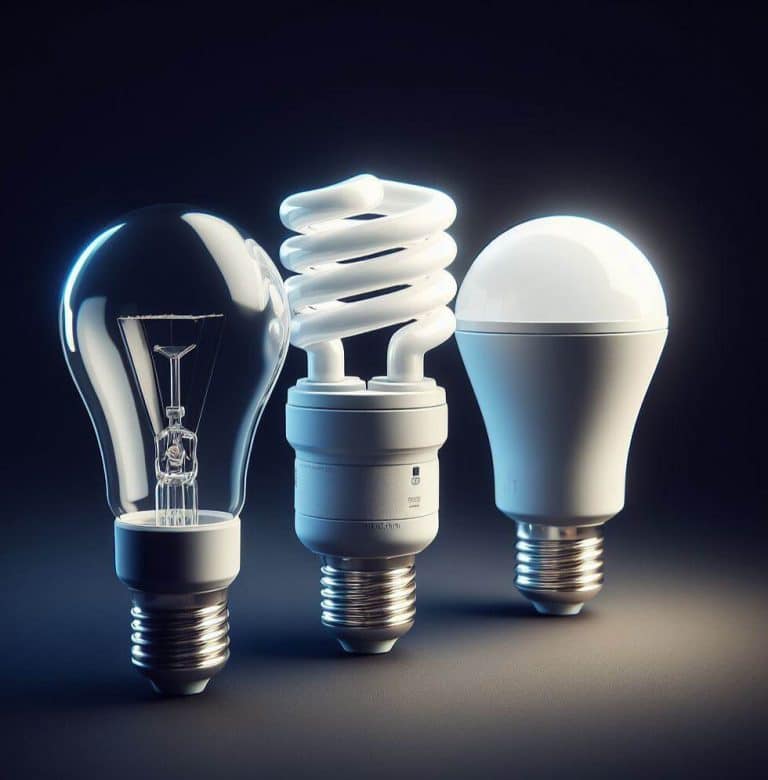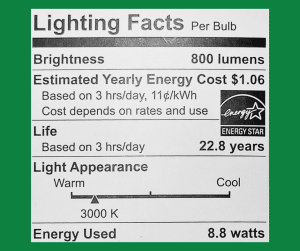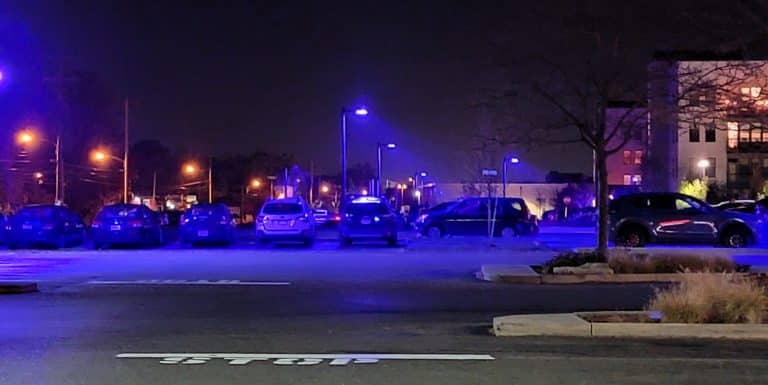
A lumen is the light output from a source that remains constant regardless of distance. LEDs, or light emitting diodes, produce light from diodes in a bulb or fixture. These small light dots allow for focused light output in a specific direction. LEDs consume less electricity than their predecessors, with a higher lumens per Watt ratio indicating higher efficiency. Most LED products have a lumens per Watt ratio of 100 or higher. Different LEDs have varying lumens per Watt efficacy scales depending on their intended use but we’ll save that for another discussion.

Brightness is the lumen output. Feit Electric gives a simple conversion chart for upgrading from incandescent or CFL to LED’s:
Energy Cost and Life of bulb are the next two items on the label. The estimated yearly energy cost is based on a stated $/kWh from the electric utility, not what is on the label. The rating of expectations for life is based on laboratory testing (i.e., 3 hours of daily use correlates to 22.8 years of life) and real-life applications may dictate more or less hours of use. Look for the ENERGY STAR® label or DLC label to ensure efficiency and performance.
Light Appearance refers to the color correlated temperature, or the color of light that your eye perceives (measured in Kelvin (K)).
Some lights used in commercial settings are 3500K because it is a good middle ground.
Blue light/cool light may not be optimal in spaces for relaxation and sleep.
Energy Used (Watt) is the power required to turn the bulb on. This can help you understand your lumens per Watt ratio.
A member of the Energility team installed Wi-Fi enabled light bulbs in their living room’s overhead light. They chose these bulbs after installing a new ceiling fan that required Edison-style bulbs for aesthetic purposes. Initially, they used standard LED Edison bulbs. However, in the evening, when it was time to relax, they found the room to be excessively bright. To address this issue, they purchased Wi-Fi enabled lights that could be dimmed using a smartphone app. The app provided various options to adjust the lights’ brightness and temperature, allowing for a cooler and brighter setting in the morning to aid in waking up, and a warmer and dimmer ambiance in the evening for relaxation. Furthermore, the app enabled them to program the lights to turn on and off at desired times, eliminating the need to manually adjust timers for their old floor lights. They did mention that finding Wi-Fi enabled Edison bulbs was a bit challenging, and they were not inexpensive. However, they believe that the investment has been well worth it.

Have you ever noticed purple or blue street lights or lights in parking lots? I have, and there’s one particular set of these lights in an area I frequently pass by. I was certain I would have noticed if the parking lot had blue lights before. It made me wonder if they were some kind of security feature. However, the blue lights didn’t really make the parking lot any brighter, so that explanation didn’t seem plausible. Curiosity piqued, I turned to Google to find out why parking lot lights are blue or purple, and I came across numerous articles discussing purple or blue street lights in various locations across the US.
Upon investigation, I discovered that the cause of this issue lies with a faulty diode coating within the light fixture. Interestingly, the diode itself would emit a blue hue if not for a coating that is intended to produce white light. However, a defect in these lights occurs when the coating on the diodes deteriorates, resulting in an unusual blue or purple illumination. For further insights into the phenomenon of purple streetlights, I recommend reading the article Why Are Streetlights Turning Purple? by Dark Sky Consulting.
Make sure globes and shades are on a regular cleaning schedule. We recently took the globe off the ceiling light by the stove and cleaned it. We were amazed at how much brighter the kitchen was with just a simple cleaning. Dust the bulbs themselves (while off) as the dust build up over time diminishes the light output.
